If you are doubtful whether climate change is “real”, just ask a farmer. Set aside the debate over the degree to which humans or natural cycles are driving it, farmers globally are grappling with temperature extremes, droughts broken by intense rainfalls and flooding, increasing wind intensity, and more and more dangerous pests. It’s a global threat.
As crop productivity is particularly sensitive to shifting and increasingly unfavorable weather patterns, farmers need to find ways to enhance their system’s resilience. As with other sectors, agriculture needs to address its unique emissions “footprint.” But looking beyond these challenges, agriculture has the opportunity to help mitigate the threat of climate change.
There are a number of practices that farmers could adopt to manage their land in ways that would optimally remove carbon dioxide from the atmosphere and store it underground in stable forms of organic matter. Such systems could be called “climate action farming.” While these practices are fairly well known they are not yet widely adopted because of practical and economic challenges. It will take a true paradigm shift in mainstream farming for these methods to be adopted at the scale and in the time frame necessary to have sufficient impact on the trajectory of climate change.
Here’s what can be done
Fortunately, there is a historical precedent — a similarly significant farming paradigm shift, a response to a different environmental crisis of human origin that helped rescue American agriculture 90 years ago. The crisis was the Dust Bowl of the 1930s and the solution that evolved was something called “no-till farming.”
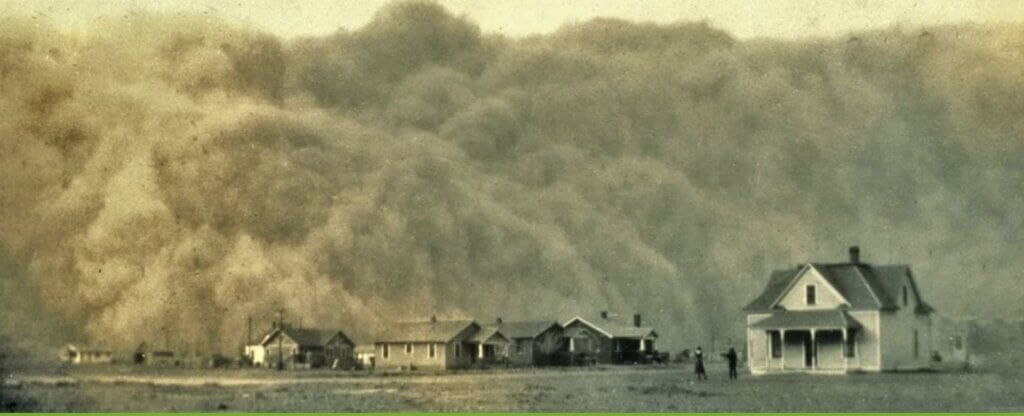
This year marks the 60th anniversary of the first commercial “no-till” field grown in Kentucky in 1962. What is no-till farming and why is it so important for addressing climate change?
Minimum tillage is the foundation for climate action farming as the potential to capture and store carbon is enhanced by complimenting that system with things like cover crops, some diverse crop rotation or double cropping options, certain forms of animal farming integrations, and controlled wheel traffic to minimize soil compaction.
Unfortunately, traditional farming methods depend on plowing and tillage to control weeds and to prepare a seed bed. In the process, they degrade the soil. Much of the captured carbon dioxide is then released through accelerated microbial breakdown of the organic matter, the soil particles become smaller and more susceptible to erosion, and earthworm populations crash. These tilled soils are less able to capture and store water. The impacts of tillage have always been problematic, but they are more so in an age of climate change with greater heat stress and more extreme rainfall and drought events.
In contrast, no-till farming systems developed over the last 60 years are able to restore soil health, give crops greater climate resilience and reduce the use of fossil fuel for the plowing process. No-till farming is a system that avoids virtually all mechanical disruption of soil. It was originally developed as a solution to soil erosion.

Here is how it works. Undisturbed, natural soils are diverse, living systems that are fed by the roots of growing plants. Over time some of the carbon captured by the plants is stored in the soil in the form of long-lived organic chemicals that help to form three-dimensional aggregated particles that give the soil physical stability, air circulation and nutrient buffering. The plants are able to absorb key nutrients through their roots for growth, and then earthworms help to recycle those nutrients by carrying some of last season’s plant material down from the surface through their tunnels that also enhance aeration. The resulting, healthy soils are good at capturing and storing rainwater and at resisting erosion by wind or water.
Sixty years ago, no-till was a radical concept. Today, more than 100 million acres of US farmland are tended using no-till and related methods. According to the United Nations Environmental Program, no-tillage operations in the United States have helped avoid 241 million metric tons of carbon dioxide since the 1970s. That’s equivalent to the annual emissions of about 50 million cars.
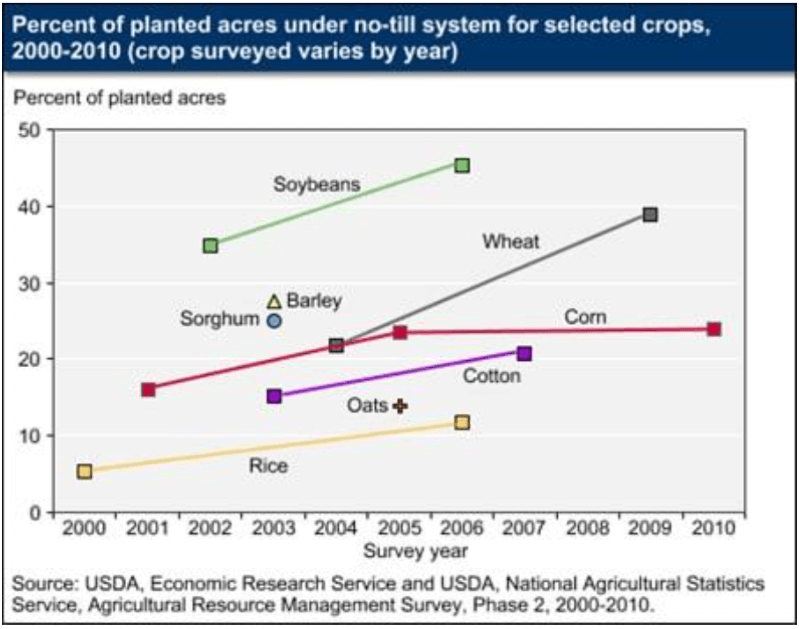
History of no-till farming: From concept to applied research
It is important to understand what enabled the large-scale shift to minimum tillage and also to identify the factors that stood in the way because these same factors will almost certainly influence the trajectory of agriculture’s role in addressing climate challenges going forward
The Dust Bowl was a prolonged and massive series of wind erosion events that occurred during a drought in the 1930s.
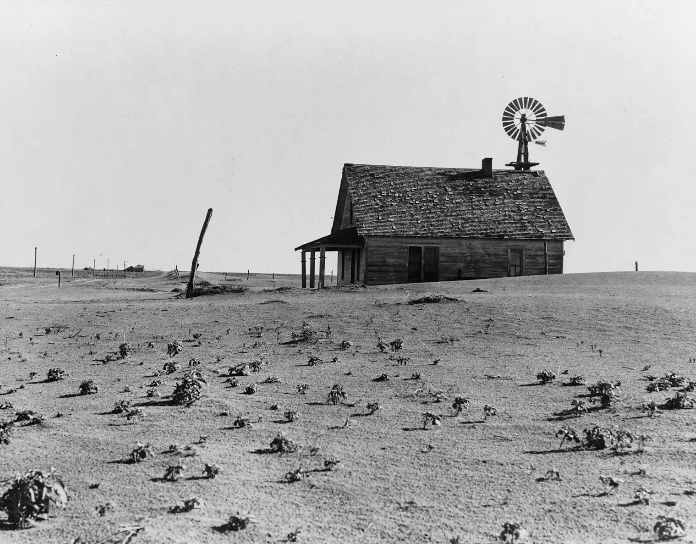
Leading up to that time, what had once been deep, rich prairie soil had been degraded by decades of plow-intensive farming methods. In 1934 a soil surveyor named Hugh Hammond Bennett timed his congressional testimony about the crisis to a day when one of those dust clouds was sweeping over Washington DC.

Congress acted unanimously to establish the Soil Conservation Service which made some progress in reducing erosion with “conservation tillage” methods that involved less dramatic soil disturbance, but the fundamental farming paradigm had not changed; nor had the erosion problem been fully addressed. Then in 1943 an agricultural agent in Ohio named William Faulkner published a book titled “Plowman’s Folly” which raised the then radical concept of farming without any plowing or “tillage” as the solution to wind and water erosion.
Faulkner’s vision of farming without the use of the plow was initially advanced through the efforts of visionary mechanical engineers and agronomists in the public sector. They developed prototype equipment and did the trial and error in field plots until they had systems that could be shown to farmers, often in the form of a demonstration plot. It was one such demo by an agronomist from Illinois named George McKibben that inspired that Kentucky farmer to try no-tilling in 1962. There was also a good deal of ongoing cooperation between the researchers and the early adopters of no-till because both then and now the growers have much to add to the process as described in the next section.
There has been a great deal of public sector research on the other climate action procedures such as cover cropping, forage double cropping, and non-traditional crop rotations. A watch-out for today is declining funding for that sort of public, applied research, and a shortage of young people pursuing careers in agricultural sciences at just the time when the baby boom generation is retiring. Hopefully increasing climate concern could help remedy that situation.
Farmer leaders
After the research phase for new cropping methods, the next stage was early commercialization. Dwane Beck, the long-term director of the Dakota Lakes Research Farm, says that there are three groups that provided the leadership during this phase: innovators, adapters and early adopters.
The innovators are those who have the inclination to try out-of-the-box ideas and who are not dissuaded by the potential for failure. As Beck puts it, “if you don’t ever fail you aren’t being creative enough.” Some of their ideas actually worked. It then fell to the adapters to work out the practical details. These two groups were often involved in the development of new, specialized machinery long before the mainstream manufacturers stepped in.
In the next stage, early adopter farmers are open to new ideas; they need to see and touch real-world examples before trying it out on their own farms.
These three kinds of farmers are the kind of leaders needed to advance climate-action farming. Agricultural trade publications such as No-till Farmer, Strip-Till Farmer and Progressive Farmer are full of stories about these leaders and their innovation with new methods and systems. This is the base for the next phase of wider adoption.
Community reactions
The early adopters of no-till faced criticism and even ridicule about their “trashy farms,” so much so that many avoided the traditional coffee shop meeting places where they would be subject to that kind of harassment. Fellow no-tillers ended up developing their own supportive communities in which they could find affirmation, encouragement, advice and assistance.
By 1972 they had their own magazine, No-till Farmer, which featured stories based on research and experience as well a cartoon series featuring tongue in cheek exchanges between Plowman Pete and No-till Ned.
They instituted annual meetings and gave out No-till Innovator awards.

Farmers who self-identify as “No-tillers” still comprise a distinct community today as do “strip-tillers” who favor a different, but still soil health-compatible approach. Strip-till is a field tillage system that combines no-till and shallow tillage of strip that make up a small portion of the field to produce row crops. Strip–till systems remove residue from the soil surface over the seedbed, resulting in soil temperatures similar to conventional tillage systems.
Most observers agree that these cutting-edge farmers are most likely to drive the expansion of climate action farming. Climate activists in the non-farming population need to see past the unfair but all too common portrayal of agriculture as a faceless, monolithic sector engaged in “industrial farming.” Yes, it is an industry (and an amazingly productive one), but it is made up of nearly all family farms and it includes a sizable subset of thoughtful people who should be seen and respected as climate care allies, not as an enemy.
Pest management
As one of the main purposes of tillage is to take care of weeds, no-till farmers had to find other ways to manage them. The adoption of no-till increased more rapidly once certain key herbicides, such as glyphosate, paraquat, and 2,4-D became available in the 1970s through the early 90s. Herbicides also enabled “termination” of the vegetation that was kept on the field from fall through spring without soil disturbance.
Another major driver of no-till expansion was the introduction of genetically engineered, herbicide-tolerant crops, starting in the 1990s, with glyphosate-tolerant crops the most popular. As farmers adapted to the new technology, some complications emerged. Weed control, an ongoing challenge for all of agriculture, is now complicated by the emergence of herbicide-resistant weed species, regulatory limitations and the difficulty of finding new herbicide chemistry.
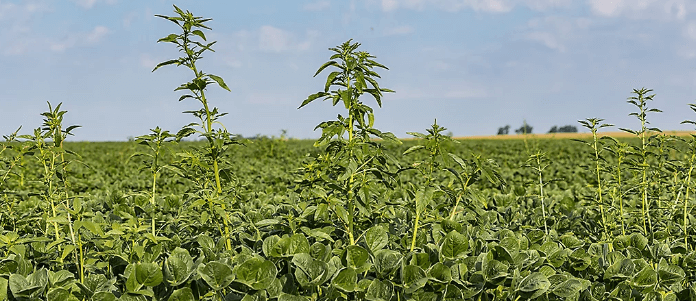
Some of the climate care practices can help with weed management while others create new weed and vegetation management issues. Herbicides will continue to be important, but there is a great deal of room for innovation here including things like small, autonomous mobile devices that are guided by aerial imagery to hunt down and mechanically terminate invasive weeds.
Does no-till make economic sense?
Farming is a business, and generally one that is high risk with moderate reward. The transition to no-till does save money because of reduced fuel consumption, but there are capital expenses for the specialized equipment. Over time untilled farmland fields can produce higher yields, particularly under drought stress. This is because undisturbed soil has larger “aggregates” and more earthworm activity which allows it to better aerate, better capture and retain rain or irrigation water, and more effectively buffer nutrient supplies. Thus, the system tends to pay for itself in the medium term.
Climate action farming systems further enhance these soil health benefits, and they have some bottom-line impacts through reduced fertilizer requirements or revenue from grazing or through double cropping. Some systems can reduce income if some growing seasons are devoted to less profitable rotational crops – for instance in order to increase carbon capture with deep-rooted crops. There are seed and fertilizer costs for some practices. In any case these systems may eventually be able to pay for themselves. These economic tradeoffs are a logical topic for applied research in the public sector and something that would also logically fall to the “adapters” described above.
There are ways that farmers can be paid to farm in ways that sequester carbon. Companies can buy carbon credits if they have a carbon footprint goal that they can’t achieve by reducing their own emissions. McKinsey estimates that there will be a $50 billion market for carbon credits by 2030. There are programs specifically designed to pay farmers to adopt practices in the climate action category.
But questions abound both from within and outside the farming community. Can it pay enough to make it worthwhile for the farmers? Does it discriminate against those who have already made desirable changes? How should the sequestration be measured and verified? What about rented land on which the next lease-holder may change practices? What happens after a contract expires? [There is a thorough exploration of these questions in the farming trade publication AgriPulse.]
Biotechnology revolution is key
There are major efforts underway to use genetic improvement methods to develop crops that are more climate resilient, more productive and more pest resistant. Some of this can be accomplished through conventional breeding, but CRISPR gene editing and other modern biotechnology tools are in many cases more effective. It may also be possible to modify crops in ways that make them even better at carbon capture and storage.
Unfortunately, there are significant barriers that limit the use of advanced genetic technologies for all but a few crops in selected regions. Some industries, such as citrus growers, have been reluctant to adopt biotechnology techniques for fear of consumer resistance even in cases in which genetic engineering could help contain its biggest nemesis, citrus greening.
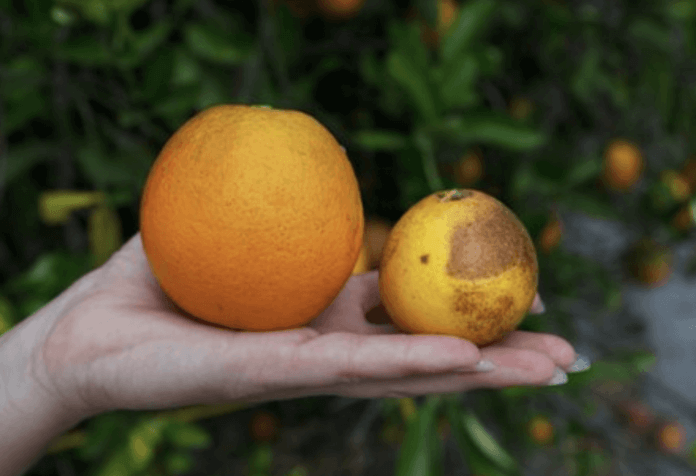
The European Union, most prominently among some regions and countries, has ignored the advice of their own scientists and blocked most uses of genetic engineering that could benefit their own farmers and the public. EU rejectionism has had global implications. Through their leverage as a major importer and through post-colonial influence in Africa and elsewhere, they have effectively blocked these technologies being used on other crops (e.g. wheat, although a climate-adaptive GE wheat is now grown in Argentina and exported elsewhere). There had been some hope that the next generation of genetic technology, gene editing, would break through these barriers, but this remains uncertain at best.
Can organic or ‘regenerative agriculture’ utilize no-till?
The term “regenerative agriculture” is often used in discussions of how agriculture can contribute to climate action. As with organic, the diverse and evolving definitions for what is considered regenerative are often ideological rather than scientific, excluding synthetic fertilizers and crop protection products and also excluding “GMOs” and gene editing.
In terms of soil disturbance regenerative agriculture definitions typically call for the use of “conservation tillage” because without herbicides, true no-till or strip-till is impractical at scale.
A technologically constrained, organic-like system is definitely not a good model for climate action farming. Organic farming has a clearly documented yield disadvantage — on average 15-40% — which means that if it were ever to be widely practiced it would require the use of much more land just to maintain current yields, a climate-unfriendly proposition in a world in which there is no more arable land, save for clear-cutting forestry.
Also, the organic business model depends on a price premium, sometimes double the price of conventionally produced food, with no evidence of nutrition or health advantages. This makes it inherently worse at serving those in lower economic strata. No-till has seen vastly more adoption than organic, particularly for the row crops which represent the majority of land available for agricultural carbon sequestration. Yet there was never a price premium associated with the crops that were managed with that system.
If society hopes to see farmers play a role in climate change mitigation, it is more appropriate to respectfully ask them “what can you do?” rather than to tell them to do something without the help of key technologies. The ideas, innovation, communities, and technologies that enabled large-scale adoption of no-till farming represent an encouraging model for how agriculture could make a next-generation farming method paradigm shift.
Only farmers can make this happen. They need research support, rational regulations, possibly carbon market income, understanding land owners, and the respect of the broader climate action movement. This challenge is too important to intermingle with ideological or marketing agendas.
Steve Savage is a plant pathologist and senior contributor to the GLP. Follow Steve on Twitter @grapedoc
Jon Entine is the founding executive director of the Genetic Literacy Project, and winner of 19 major journalism awards. He has written extensively in the popular and academic press on agricultural and population genetics. You can follow him on Twitter @JonEntine































